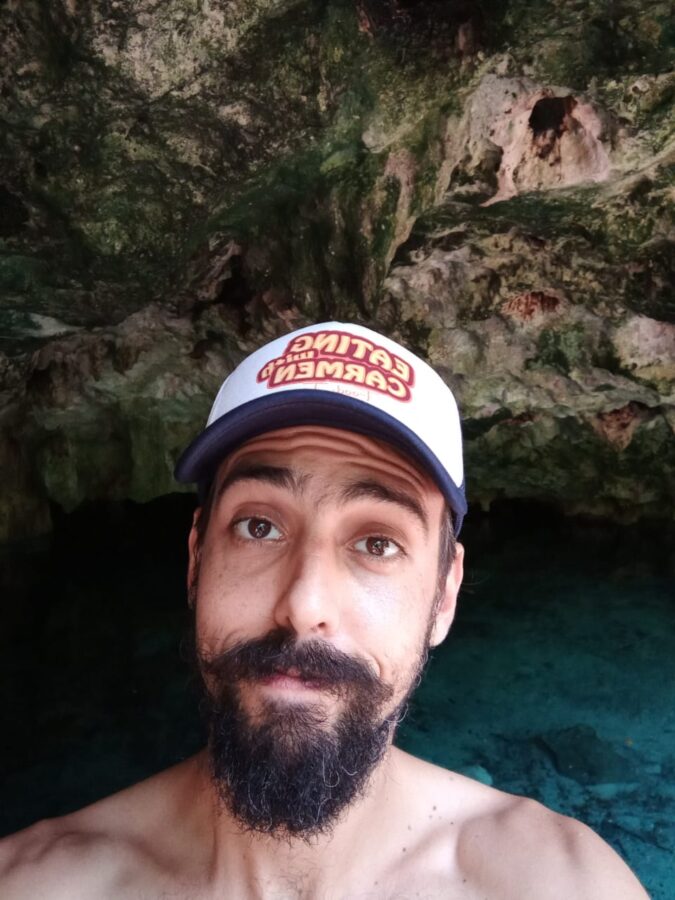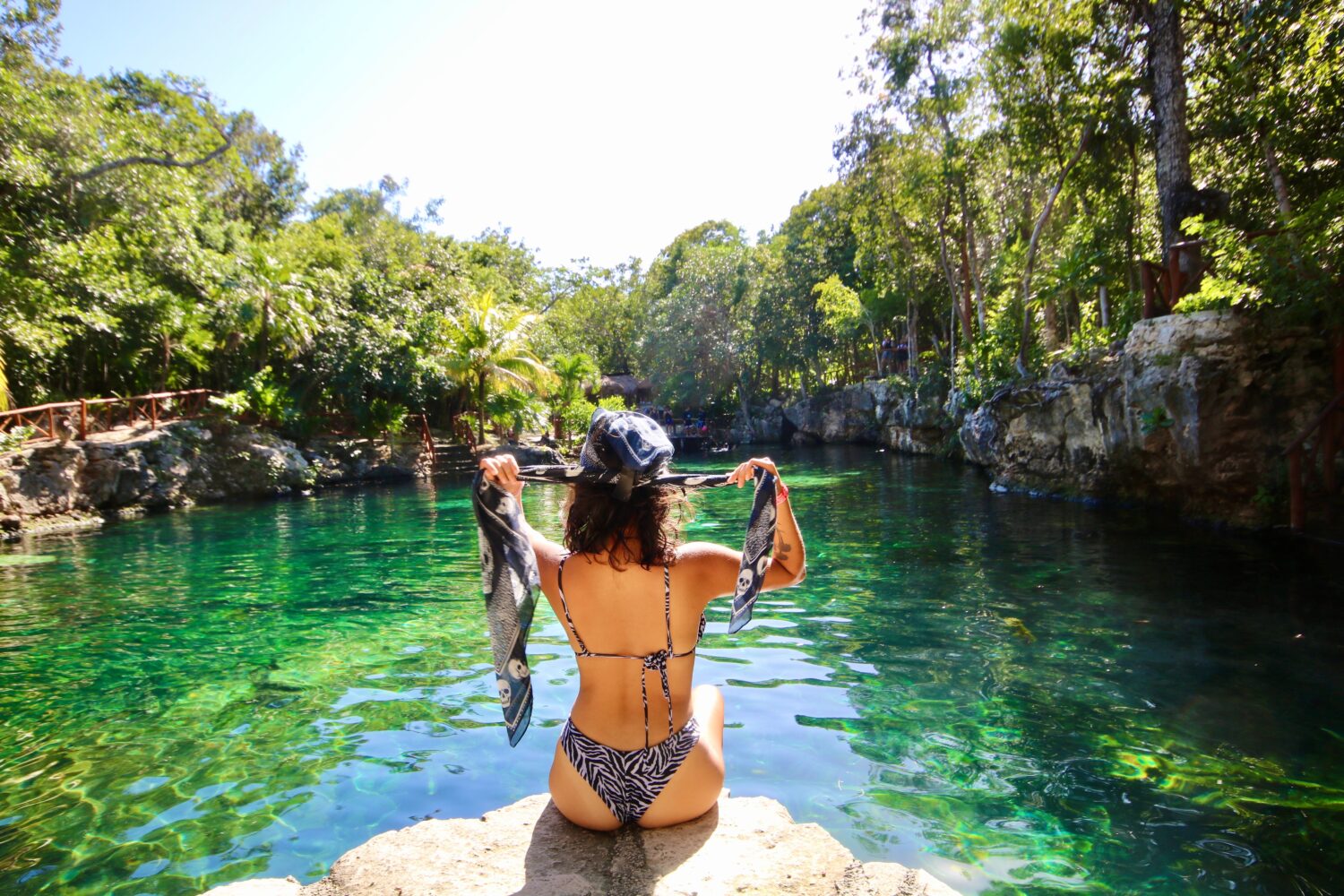One of the most unique attractions in The Mayan Riviera is, beyond doubt, the amazing Cenotes! (Ce-no-teh)
Cenote comes from the Mayan word “ts’onot” which means “hole with water”, and as it is with most Mayan names, it’s pretty descriptive. The main component of the ground in the Yucatan peninsula is limestone, over time the limestone has eroded giving way to water, creating these amazing natural pools. There are different types of Cenotes, depending on their age. The oldest ones are open, water has gone all the way to the surface so it looks just like a swimming pool with fresh water, then we have the “semi-open” cenotes where there’s an opening or an entrance to a cave before the water level, and the youngest ones are underwater caverns than can only be accessed by snorkeling or cave-diving.
For the ancient Mayans, these caves represented the entrance to Xibalbá, their Underworld, and there’s no question that all of them hold a magic atmosphere that gives them a unique appeal to travelers around the world.
So often on our tours, my fellow foodies ask me for recommendations for Cenotes, so I’ve decided to create my top 10, but of course, I’m not going to be subjective about this. As always my goal is to give people as much useful information as possible for their vacations on these beautiful shores. So after thorough research and analysis, and swimming in cool refreshing waters, I give you my top 10 Cenotes in Riviera Maya, I’m not even gonna number them, I’m giving you the facts so you can decide which ones sound best for you.
But before I do, I want to address that IN EVERY CENOTE THE USE OF SUNSCREEN IS STRICTLY PROHIBITED! Cenotes are very frail ecosystems that provide fresh water to a lot of living organisms, if you put sunscreen or any other chemical product (bug repellent, makeup, body lotion, etc), regardless of it being “biodegradable”, before entering the water, you are introducing a foreign chemical agent to the ecosystem, polluting these sacred waters and affecting all the life that depends on them. Please, for the love of everything you hold dear:
DO NOT USE SUNSCREEN OR ANY OTHER CHEMICAL ON YOUR SKIN BEFORE ENTERING THE WATER!
Gracias 🙂
CENOTE AKTUN CHEN
Google rating: 4.8
Aktun Chen is more than just a Cenote, it’s an EcoPark located halfway between Playa del Carmen and Tulum, so in a way is very touristy and because of that the cost of admission is higher than any other cenote, however, you are paying for a whole experience, not just an afternoon hanging out, swimming in fresh waters.
Apart from all the wildlife you’ll be able to see around the area, the guided tours through the caves and underground river will give you sights to behold, thanks to all the carefully placed ambiance lighting all around the caves.

Credit: https://aktun-chen.com/es/cave-item
They sell separate tours, but perhaps the most cost-effective plan is to buy the combo package that includes all the activities plus the food for $106 USD per adult, or $85 USD per kid.
CENOTE SAC ACTUN
Google rating: 4.8
Sac Actun is a whole system of underwater interconnected caves, it’s huge! You can find this place only 16 miles north of Tulum and it doesn’t matter if you’re a cave diver or just a snorkeling tourist, in Sac Actun you’re in for a spectacle.
There’s a lot of history to discover in this underwater world. It was initially called “Pet Cemetery” due to the large number of animal fossils they’ve found, including prehistoric elephants and giant sloths.
The oldest human skeleton (12,600 years old) found in Latin America was discovered inside one of the cenotes in this site, called “The Black Hole”
Those are some of the reasons a lot of divers and tourists alike spend hours exploring this breathtaking natural wonder.
Admission is $35 USD per person, you can explore on your own, or there you can find licensed tour guides to accompany you through the caves.

Credit: https://topadventure.com/
CENOTE ESCONDIDO
Google rating: 4.7
If you’re not interested in the tourist crowds and are looking for a more “local” experience, head only 2 miles southwest of Tulum down the 307 and you’ll find Cenote Escondido, an open cenote with crystal clear water that will make you feel like you’ve reached Nirvana.
It’s not so popular amongst tourists and is not a part of any of the big cenote excursions so you can be lucky enough to be one of the few people there on a regular weekday.
They have basic facilities, like restrooms and changing rooms, however, bring your own food and water if you want to spend the day there. It’s a great place to practice freediving, snorkel, or just hang out around nature.
General admission also includes entrance to Cenote Cristal right next to Cenote Escondido and is only $6 USD or $10 USD if you want to scuba dive.

Credit: https://www.elcaminomascorto.es
CENOTE CHAAK TUN
Google rating: 4.7
Most people don’t know it but Cenote Chaak Tun is actually inside Playa del Carmen, on the southwest side of the city.
Apart from its convenient location, they have a well-designed tour and very nice facilities, it’s very tourist-oriented and all their guides speak English.
The experience lasts about two hours as you snorkel through 3 interconnected caves while learning about Mayan traditions.
Cost is $40 USD per adult and $27 USD per kid, but they offer 20% discount if you book 3 or more days before on their website: https://chaaktun.com.mx/
With the cost of the tour you get all the gear you’ll need and a bottle of water.

Credit: https://assets.simpleviewinc.com
CENOTE AZUL
Google rating: 4.7
One of the most popular Cenotes preferred by both tourists and locals alike is Cenote Azul.
A big open cenote with different pits and depths is a great place to spend the day with your family swimming, snorkeling, or cave diving. It’s located 15 miles south of Playa del Carmen down highway 307. Don’t forget to check out our article How to get around like a local to learn the best way to get to this and the rest of the cenotes.
General admision is $6 USD per adult, and $4 USD per kid. You can rent snorkeling gear there but it’s always best if you bring your own. There’s an area where you can buy food and drinks and they also allow you to bring in your own fruits.

Credit: https://www.playadelcarmen.com
CENOTE DOS OJOS
Google rating: 4.7
I gotta say this is one of my favorite cenotes. It’s called Dos Ojos (Two eyes) because it consists of two main caves interconnected by an underwater passage that you can snorkel or scuba dive through!
The east cave, also known as the “east eye”, is a semi-open cenote with plenty of natural light and crystal clear waters so the underwater sights are beautiful, and if you take a guided snorkeling tour you can visit the west cave, also known as “The Batcave”, which is almost closed with little to no natural light, home to a lot of bats that give the cave its name.
There’s also a cave diving route of over 500 yards, with no current and a shallow depth of 22ft so you don’t need to be an experienced diver to enjoy this adventure.
General admission is about $17 USD and the snorkeling tour, which is highly recommended is $35 USD.
Cenote Dos Ojos is located about 14 miles north of Tulum in Dos Ojos Eco Park, home of three other cenotes Nicte Ha, Jaguar, and Los Monos, admission to these cenotes is separate.

Credit: https://www.thebarefootnomad.com
CENOTE CRISTALINO
Google Rating: 4.6
Just two miles south of Puerto Aventuras you can find this breathtaking paradise. This open cenote is very accessible both on price and location, and it’s very popular because of that.
You can avoid the crowds by going during the middle of the week, but don’t expect to have this place for yourself.
It’s got a lot of different areas to explore including a diving platform to show everyone how brave you are jumping into the cenote. The facilities might not be top of the line however they’re clean and well maintained. They have showers, restrooms, changing rooms. You can buy food and beverages, and rent snorkeling gear or bring your own. Prices are $6 USD or $10 USD if you want to scuba dive.

Credit: https://www.elcaminomascorto.es
CENOTE CHAC MOOL
Google Rating: 4.5
One of the best cenotes for cave-diving, however, snorkeling is not allowed.
The cenote has three different access points and it can go down to 36 feet deep, which makes it friendly for inexperienced divers.
In the depths of these waters, you can find a very interesting phenomenon called a halocline. Salt water, being denser than fresh water, stays in the bottom of the caves, coming through the rocks from the ocean. Fresh water is basically rain filtered from the surface. At the point where the two types of water meet the halocline creates cool swirly visual effects.
There are many scuba centers that offer tours to this cenote so check for the one that suits you best.

Credit: https://www.plutodive.com/
GRAN CENOTE
Google Rating: 4.5
Not every cenote is down the 307. Gran Cenote is located on Highway 109, 5 miles up the road from Tulum to Cobá.
Gran cenote is a huge semi-open cenote, the open side of it is big and not too deep, perfect for snorkeling, but if you’re interested in cave diving, the closed part with a depth of almost 50 feet will probably catch your interest.
Basic facilities are well maintained, and the price is around $15 USD per person.

Credit: https://www.plutodive.com/
CENOTE SIETE BOCAS
Google Rating: 4.5
The road from Puerto Morelos to Leona Vicario is known as “Ruta de los Cenotes”, on the 12th mile you’re going to find this underground system of rivers with seven different entrances giving this place the name of Siete Bocas or Seven Mouths.
Some of these entrances are just holes in the ground where you can jump into an underground water cave.
Because of its location is hard to get there on public transport, so you might consider getting a tour that includes transportation or better even, rent your own car.
General admission is $15 USD per person, and I must say I find this a bit overpriced since the facilities are in no way better than the ones you’ll find in cenotes that charge half that price. However, there are a lot of things you can do and places you can explore on this site and it’s completely worth the visit.

Credit: https://menteurbana.mx/
WHEN IS THE BEST TIME TO VISIT CENOTES?
There you go, in my opinion, those are the best 10 cenotes you can find in the Riviera Maya, and the best time to visit these amazing, cool, natural, freshwater pools is any hot day which in this area is the standard year-round.
Consider that most cenotes close at 5 pm at the latest, 3 pm being more the standard, so plan your cenote visit as a morning activity, and then maybe join us for a food tour in the afternoon. 😉
In the meantime, I’ll be expecting you while enjoying the jungle.
Until next we meet my foodies.
- Your Professional Foodie, The Juan and Only.







